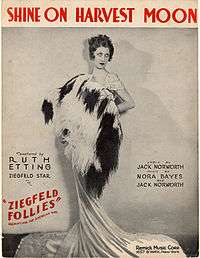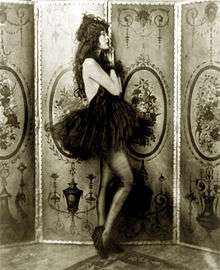Ziegfeld girl
Ziegfeld Girls were the chorus girls and show girls from Florenz Ziegfeld's theatrical Broadway revue spectaculars known as the Ziegfeld Follies (1907–1931), in New York City, which were based on the Folies Bergère of Paris. The term is often used too broadly. For example, Marion Davies was not a Ziegfeld Girl; she was a featured player in the 1916 edition of the Follies and not a chorus girl or show girl.
Description

These showgirls followed on the heels of the "Florodora girls", who had started to "loosen the corset" of the Gibson Girl in the early years of the twentieth century. These beauties, decked out in Erté designs, gained many young male admirers and became objects of popular adoration. All of the showgirls looked very similar, both in appearance and in stature. They danced in complete synchronization, and were the only act that was uniform in the Ziegfeld Follies. Many were persuaded to leave the show to marry, some to men of substantial wealth. The Ziegfeld Ball in New York City continued as a social event of the season for years after the last production of the Follies.
In 1897, Ziegfeld married one of his Ziegfeld girls, Anna Held, by common-law. They were never legally married, but lived together long enough to be legally considered so. In 1913, Held divorced from Ziegfeld because of his infidelities with Lillian Lorraine, another Ziegfeld girl. Held died soon after. Following that, Ziegfeld married yet another Ziegfeld girl, future film star Billie Burke. Although Ziegfeld had several affairs, Burke claimed that Lorraine was the only one that made her jealous.[1] Ziegfeld remained married to Burke (and in love with Lorraine) until his death in 1932.
List of Ziegfeld girls
Over the years, the Ziegfeld girls included many future stars such as Marion Davies, Paulette Goddard, Joan Blondell, Olive Thomas, Jeanne Eagels, Barbara Stanwyck, Billie Dove, Louise Brooks, Nita Naldi, Julanne Johnston, Mae Murray, Dorothy Mackaill, Odette Myrtil, Lilyan Tashman, Claire Dodd, Cecile Arnold, Dolores Costello, Dorothy Sebastian, Juliette Compton, Mary Nolan, Iris Adrian and other society and business successes such as Peggy Hopkins Joyce, Helen Gallagher, Anastasia Reilly,[2] and Irene Hayes.
Resistance controversy
Ziegfeld girl and later nurse Mona Louise Parsons was a member of a resistance movement in the Netherlands during Nazi Occupation, working to return downed Allied airmen to England. She was eventually arrested by the Gestapo and became the only Canadian female civilian to be imprisoned by the Nazis, and one of the first (and few) women to be tried by a Nazi military tribunal in the Netherlands. Her original sentence was death by firing squad, but the sentence was commuted to Life with hard labour. She escaped from her captors.
Declined members

Although many future stars started out as Ziegfeld girls, many others were turned down by Florenz Ziegfeld to appear in his revue. Norma Shearer (in 1919 and 1920), Alice Faye (in 1927), Joan Crawford (in 1924), Gypsy Rose Lee (in 1927), Lucille Ball (in 1927 and 1931), Phyllis Haver (in 1915), Eleanor Powell (in 1927), Ruby Keeler (in 1924), Hedda Hopper (in 1913), and June Havoc (in 1927 and 1931) were among the many hopefuls that the master showman discarded after auditions. In 1957, the then-current members were featured as mystery guests on the television panel show What's My Line?[3]
Last survivors
The survivors of the chorus lines of the last century are The Rockettes of Radio City Music Hall. One of the last surviving Ziegfeld girls was Doris Eaton Travis, who died on May 11, 2010 at the age of 106. Another was Millicent Drahorad, who resided in Florida at the time of her death, in either 2012 or 2013 at the age of 102.
References
| Wikimedia Commons has media related to Ziegfeld girls. |
- ↑ "Ziegfeld Who's Who: A to L". www.musicals101.com. Retrieved 2016-04-21.
- ↑ Internet Broadway Database
- ↑ What's My Line? - Ziegfeld Girls; Walter Brennan; Adolph Menjou, Greer Garson (panel) (May 12, 1957)